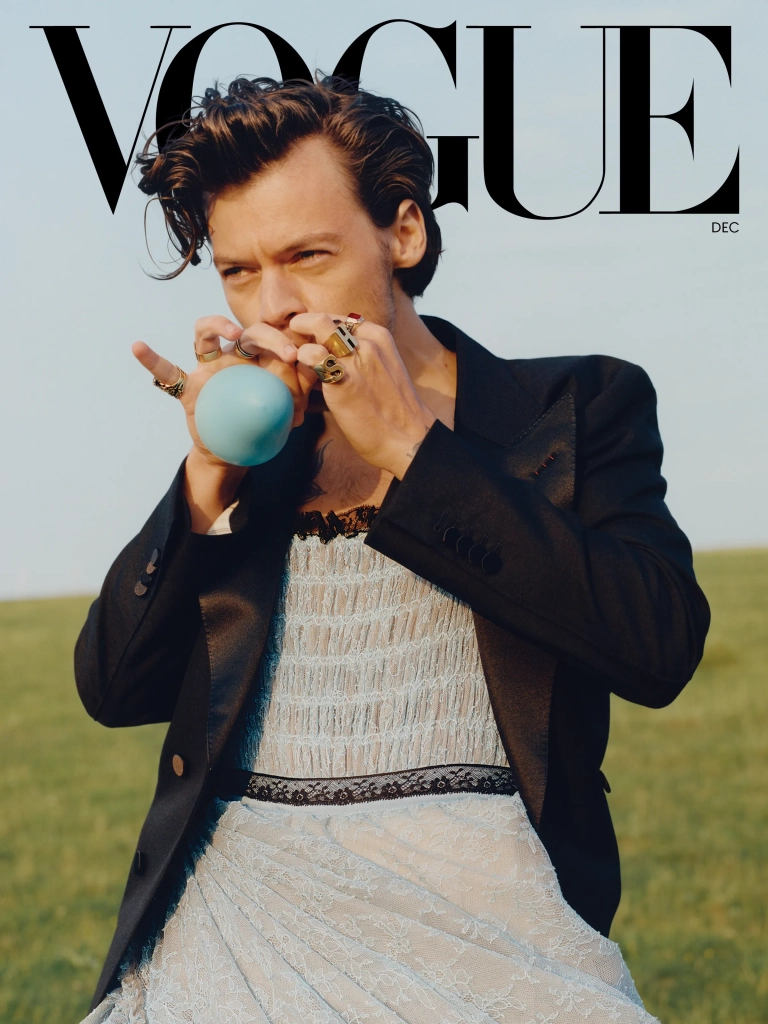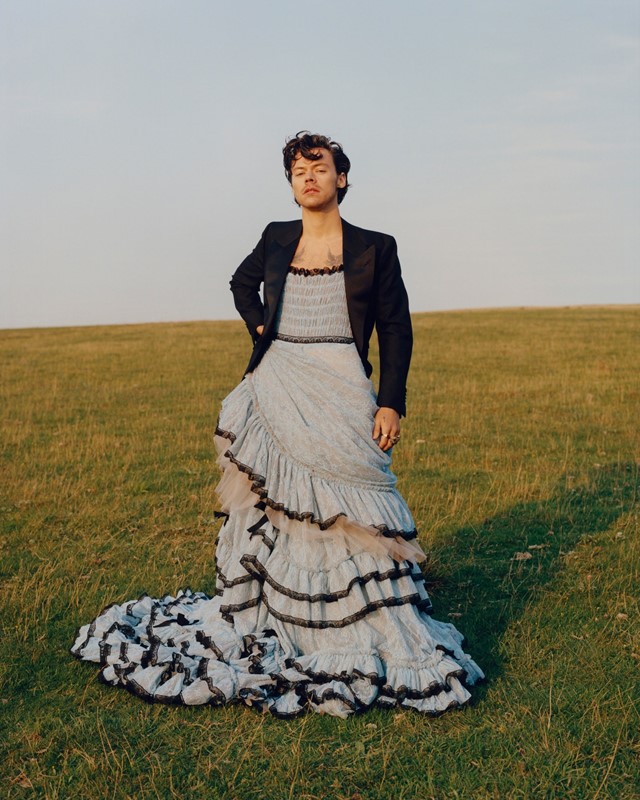Callie Mastin graduated this August with a Bachelor of Arts in Criminal Justice and International Studies with a minor in French. Callie was a student in REL 105 with Professor Griffin in Spring 2022.

It’s no secret that Harry Style’s use of gender non-conforming fashion is a hotly debated topic. When Styles, wearing a custom Gucci dress, appeared on the front cover of Vogue as the first solo male cover in Vogue’s history, both fans’ and critics’ reactions were mixed. While some people appraised Styles for breaking down traditional barriers between men’s and women’s fashion, others accused Styles of appropriating non-binary fashion. Over the course of the last unit in our semester, we have explored Martin’s concepts of legitimation, authority, and authenticity claims as they relate to religion and other cultural concepts or phenomena. For the purposes of this blog, the ways in which Martin’s concepts can be applied to the discourse surrounding Harry Styles’s Vogue cover will be analyzed.
When looking at authenticity claims related to Style’s Vogue cover, it is apparent that this claim most strongly relates to many critics’ arguments surrounding Style’s choice in fashion. For example, NPR’s article “Harry Styles isn’t the leader of a fashion revolution, but neither is Billy Porter” discusses how certain individuals in the industry such as Billy Porter heavily criticized Style’s choice in fashion due to his inauthentic claim on non-binary fashion. In an interview concerning Style’s cover, Porter argued “He doesn’t care, he’s just doing it because it’s the thing to do. This is politics for me. This is my life. I had to fight my entire life to get to the place where I could wear a dress to the Oscars … All he has to do is be white and straight” (Deng). By claiming that Styles isn’t a real non-binary fashion icon because he is “white and straight,” Porter is making an authenticity claim on who can and can not explore gender binaries through fashion: who is “in” and who is “out.” This idea strongly relates to Craig Martin’s theoretical discussion of “authenticity”; when authority figures claim a “special power or authority for their own beliefs and practices by claiming that they have the real or authentic one” a “binary opposition between the “real” or authentic and the “unreal” or inauthentic” is established that ultimately determines what people view as real and legitimate versus false and illegitimate (See Chapters 8 & 9 of Martin’s Critical Introduction to the Study of Religion).
Furthermore, Martin’s discussion of authenticity claims in Christianity states “there is not obviously one “thing” called Christianity because those things that fall under the category are constantly evolving and changing…popular cultures are not in any way immobile.” This concept relates to a quote from, the NPR article; “Porter can’t claim to own a fashion genre of fashion with a rich history led by countless other transgender and gay people of color… It’s important to respect and recognize where culture comes from, but it’s also changing and evolving to the needs of our times” (Deng). Because the idea of fashion, a cultural phenomenon, is constantly evolving, the author is essentially arguing that there will never be a singular “authentic” or “true” form of non-binary fashion. This ultimately means that Styles, as well as past and present non-binary fashion icons, can all be considered “authentic” due to fashion’s constant evolution.
Another way in which Martin’s concepts relate to Style’s Vogue cover is seen through authority claims. In the NPR article, the author gives Porter’s quote about Styles; “I changed the whole game… And that is not ego, that is just fact. I was the first one doing it and now everybody is doing it” (Deng). In his statement, Porter is claiming to be an “authority” on non-binary fashion due to his long history of challenging traditional ideas of gender expression in the fashion industry. While Porter has clearly been an icon in the non-binary fashion movement, his interview raises questions concerning authority claims and whose authority we should follow. The NPR article discusses this idea when stating that
“Porter isn’t the first celebrity to push the boundaries of gender binaries … Janelle Monáe drew attention with her choice of black and white tuxedos and suspenders as she showed women’s sexuality in a different way. Younger artists like Lil Nas X are actively shaping the future of queer representation in rap and pop music” (Deng).
This quote actively demonstrates the way in which society often must decide whose authority to trust. While Porter claims to be the main authority figure on non-binary gender fashion, the author of the NPR article claims that there are numerous other authorities in the past and the present that could also be considered authority figures on gender expression in fashion. Similar to this idea, Martin discusses how Rousseau’s critique “calls authorities into question on the basis of the fact that there are so many of them; why would we trust some and not others?”. The discourse surrounding Harry Style’s Vogue cover, specifically the opinions of Billy Porter, represents the way in which various people claim to be primary authority figures over movements in which countless people have “claims.”
Finally, Martin’s discussion of legitimation can be applied to Harry Style’s Vogue cover in a broader way. Ideas concerning gender roles in fashion have been reinforced in a similar way for countless years: women wear dresses and men do not. While women wearing pants is an accepted concept in today’s world, men wearing dresses often draws heavy criticism. As Martin states, legitimation “offers some sort of justification for conformity to a practice.” Applying this to gender roles in fashion, justification for traditional gender roles in fashion often argues that dresses are too feminine for men, not manly enough and that men wear pants because “that’s always how it’s been done”. In reality, these concepts exist because society creates and enforces them. The authors of the NPR article discuss how the “cultural zeitgeist is currently embracing alternative demonstrations of masculinity” (Deng). Because the narrative surrounding masculine dress is now shifting, Styles and other fashion icons are able to serve as tools to legitimize a more fluid way of viewing fashion.
In conclusion, Martin’s concepts can be applied to a wide array of cultural movements and phenomena. The discourse surrounding Harry Style’s Vogue cover is just one way in which claims of authority, authenticity, and legitimation influence our everyday lives. Ultimately, it is vital to question who creates these claims, why they exist, and what purpose they serve in order to better understand the way in which society functions.

Source:
https://www.npr.org/2021/10/20/1047692882/harry-styles-billy-porter-gender-fluid-fashion
I really enjoyed reading your take on this. Harry’s wardrobe choices have attracted so much attention, it is worth considering who creates gender norms and values.